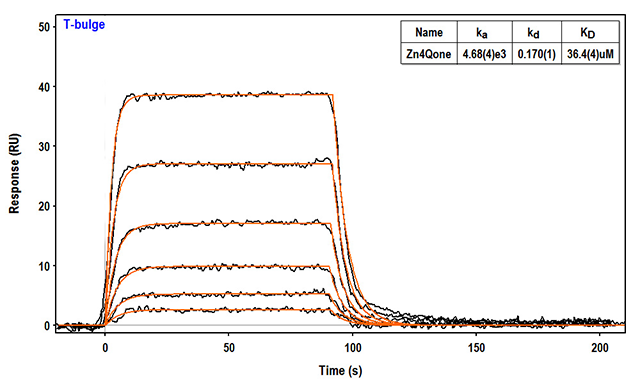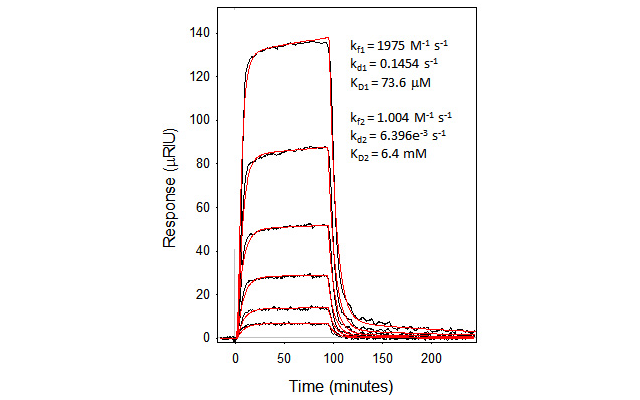Serum IgG antibody binding to recombinant Ebola virus glycoprotein (GP) immobilized on carboxymethyl dextran surface
Introduction
DNA, having been studied by researchers for decades, remains one of the most promising therapeutic targets in many interaction processes. The most common example of this type of interaction is cisplatin with the guanine nucleobase. Cisplatin recognizes, binds and kinks the DNA, preventing further replication, making it a well-known cancer therapy. Non-canonical nucleobases that are part of DNA bulges, hairpin loops, mismatches or abasic sites are common targets when designing small molecules for binding both organic and inorganic compounds. For example, Zn(II) complexes containing planar aromatic pendents with two fused rings bind to DNA Hairpin (T-bulge/T-Loop) more tightly than complexes with non-planar pendents. A less common but still interesting DNA structure is the G quadruplex (loop). G-quadruplexes are four-stranded guanine-rich structures that are found in promoter regions of DNA or at the telomeric ends of DNA (they may be also play a role in m-RNA as well). A better understanding of these types of interactions as well as the development of alternative ways to recognize unusual nucleic acid structures, may lead to improved design of small molecules for future therapeutic applications. Toward this end, we report on the use of Reichert's surface plasmon resonance (SPR) system to characterize the binding of Zn complexes to DNA T-bulge and T-loop structures.
Experimental
A summary of conditions used to study the binding of a Zn complex to two different types of DNA structures is provided here. In both cases, biotinylated DNA was injected over the sample channel only of a Streptavidin sensor chip. Biotinylation of DNA provides an easy and direct way to capture it onto the sensor chip surface. In addition, DNA biotinylated at only one point ensures that the DNA strand is in the desired orientation when captured onto the sensor chip surface. This study focuses on a Zn complex called Zn4Qone and the conditions used for this analysis are summarized in the following Table:

Results
Sensorgrams and kinetic fits obtained for Zn4Qone binding to T-bulge DNA and T-loop DNA are shown in Figures 1 and 2, respectively. The Zn complex binds more tightly to the T-bulge than to the T-Loop target. This is a general trend seen when a series of Zn complexes were injected over these two types of DNA molecules. For more information on this topic, see the journal article Dalton Trans., 2015, Vol 44, pp. 3708–3716.


Conclusions
It has been demonstrated that Reichert SPR instruments offer outstanding ability to characterize DNA-small molecule interactions. Benefits of using Reichert SPR instruments for studying nucleic acid interactions include:
- The strong interaction of the biotinylated DNA with the streptavidin Reichert SPR chip ensures that the desired DNA structure is maintained when captured on the chip
- SPR is a great way to save resources, in terms of concentration and volume, making it a very useful technique for studying low-yielding or expensive compounds and compounds with poor solubility. Alternative techniques require a higher concentration of both ligand and analyte to even see a signal (for example, ITC) and the volumes needed are much larger.
- Studying multiple complexes binding to DNA with a Reichert SPR is efficient and straightforward.
- The ability to obtain both equilibrium binding and kinetic data from the same experiment is very useful.
- When it comes to potential therapeutics, kinetics are critical. The Reichert low noise SPR is an excellent instrument to use for determining accurate kinetics. For potential therapeutics, the on rates provide insight on how quickly the interaction will occur. If the on rate is fast, relief may be immediate but if combined with a fast off rate, only transient. Frequent dosing might be needed. If the on rate is slow, it may take some time for the therapeutic to reach full effect. If a slow on rate is combined with a slow off rate, infrequent dosing may be needed. This type of information is invaluable to the Drug Discovery process.